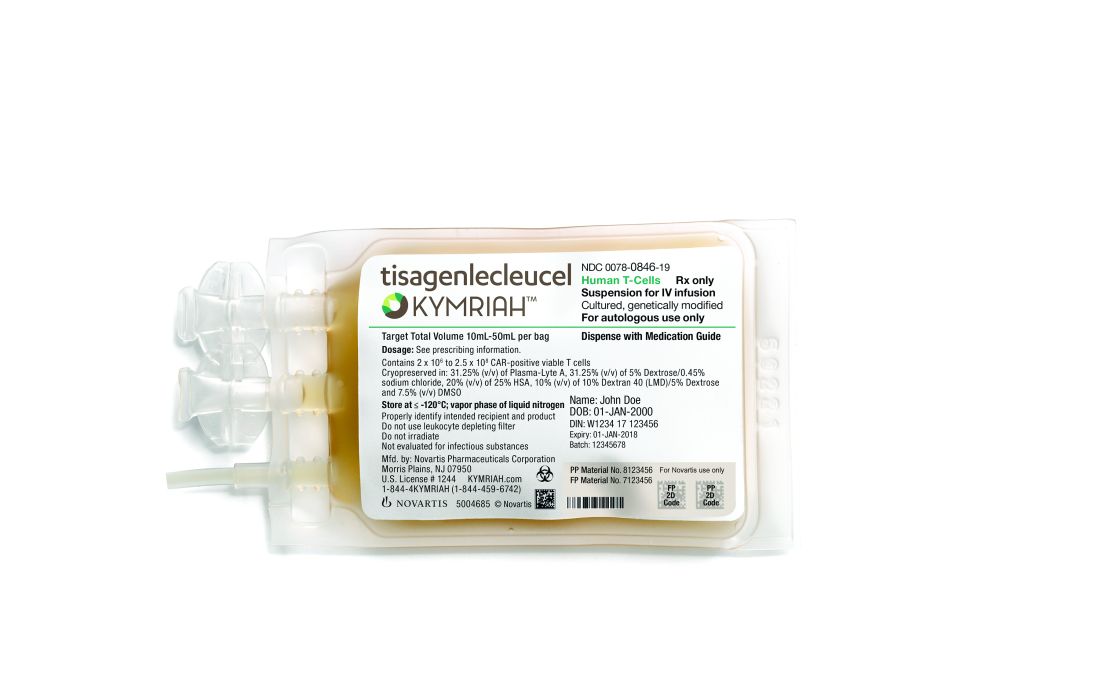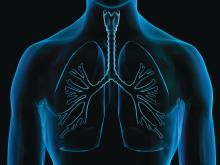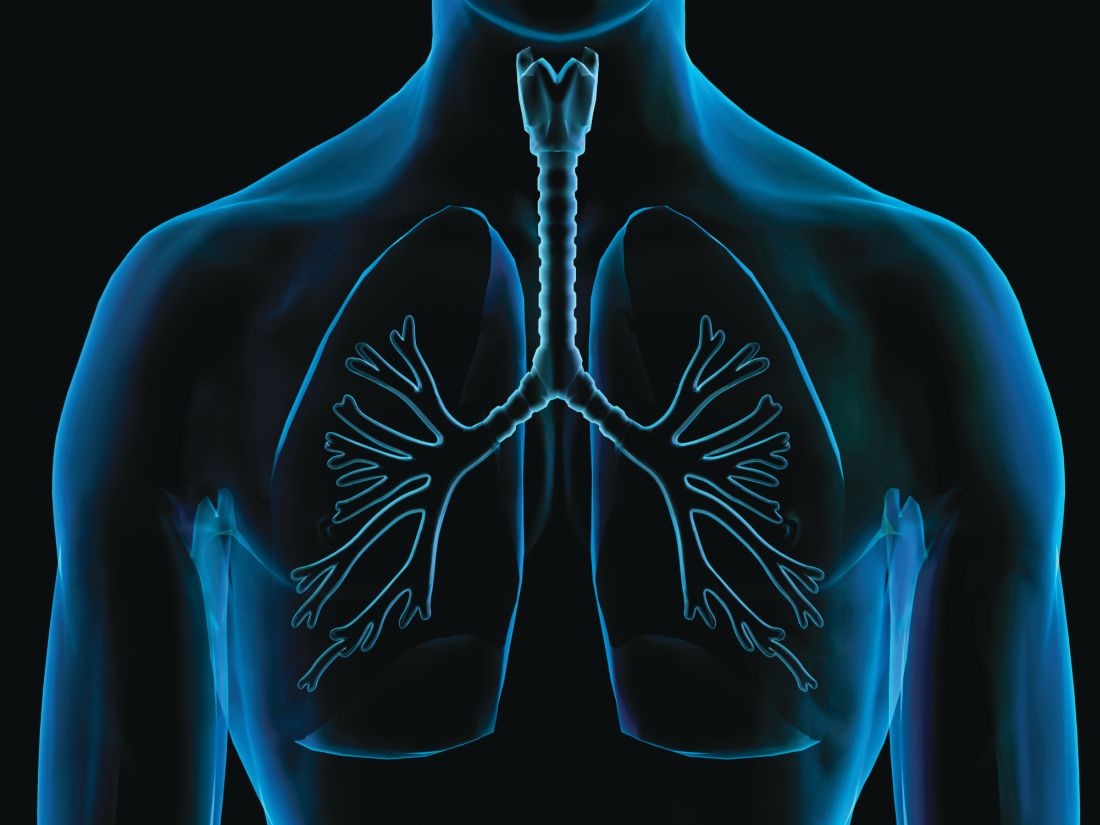User login
Methamphetamine use climbing among opioid users
SAN DIEGO – As the deadly opioid epidemic continues, a new study suggests that a fast-rising number of users are turning to another drug of abuse – methamphetamine. In some cases, a researcher says, their co-use is reminiscent of the fad for “speedball” mixtures of cocaine and heroin.
During 2011-2017, the percentage of surveyed opioid users seeking treatment who reported also using methamphetamine over the past month skyrocketed from 19% to 34%, researchers reported at the 2018 annual meeting of the College on Problems of Drug Dependence.
Use of crystal meth specifically went up by 82% and the use of prescription stimulants rose by 15%. By contrast, use of marijuana went up by just 6%, while the use of muscle relaxants and prescription sleep drugs fell by more than half.
The findings matter, because the use of multiple illicit drugs is even more dangerous than one alone, said study coauthor and doctoral candidate Matthew S. Ellis, of Washington University in St. Louis, in an interview. “Illicit opioids carry their own serious risks such as unknown purity, not knowing if heroin is laced with fentanyl, or inexperience of users who are used to clearly marked prescription pills. Add in a secondary drug, also often used in non-oral ways, and your risk for overdose is going to significantly increase.”
The rising use of methamphetamine, which comes in such forms as crystal meth, has been overshadowed by news about the opioid epidemic. Still, as a 2018 Lancet report put it, “while the opioid crisis has exploded, the lull in the methamphetamine epidemic has quietly and swiftly reversed course, now accounting for 11% of the total number of overdose deaths.”
In regard to co-use of opioids and methamphetamines, the report said, “in states including Wisconsin and Oregon, new patterns suggest they are beginning to overlap as increasing numbers of people use both drugs” (Lancet. 2018 Feb. 24;391[10122]:713).
Meanwhile, the New York Times published a story in February 2018 headlined “Meth, the forgotten killer, is back. And it’s everywhere.” It noted that meth overdose deaths in Oregon outpace those from opioids and added: “At the United States border, agents are seizing 10-20 times the amounts they did a decade ago. Methamphetamine, experts say, has never been purer, cheaper, or more lethal.”
Overall, there’s little known about co-use of opioids and methamphetamines, said study lead author Mr. Ellis. “The reason for this is that opioid use patterns and populations of users have drastically changed in the past 20 years, and continue to do so,” he said. “Methamphetamine is becoming increasingly available at the same time that heroin and illicit fentanyl are as well. Reports suggest that the United States has shifted from a market of home-grown methamphetamine to that manufactured and sent from other countries, creating a broader market than previously seen.”
For the new study, Mr. Ellis and his colleagues examined statistics from a U.S. surveillance program of opioid users entering substance abuse programs. They focused on 13,521 participants in 47 states during 2011-2017.
Of 12 drug classes examined, only co-use of methamphetamine rose significantly over the 6-year period, Mr. Ellis said.
Among demographic and geographic groups, the researchers saw the largest increases in co-use of the two drugs in the West, Northeast, and Midwest regions, in rural and suburban areas, among groups aged 18-44 years, and among whites.
Why is co-use among opioid users increasing? “We have begun to do some qualitative work with a number of participants suggesting they use opioids and methamphetamine to balance each other out,” Mr. Ellis said. “So an addict can use opioids, but if they need to go to work, they can reinvigorate themselves with methamphetamine.”
Mr. Ellis said “this is not necessarily a new trend,” noting that the co-use of the drugs is akin to the “speedball” – a mixture of cocaine and heroin designed to blend their opposite modes of action.
However, Mr. Ellis said, “ The increases in production and spread of illicit opioids and methamphetamine into an existing market of those previously using prescription opioids was a perfect storm for these two drugs to be a problem, both separately and together.”
He said researchers also are finding that “if methamphetamine is the only thing an opioid addict can find, they will use it to stave off withdrawals as well.”
Indeed, National Public Radio reported in June 2018 that “as opioids are becoming harder to obtain, more and more users are turning to cheap methamphetamine” in Ohio’s tiny Vinton County, near Columbus.
Moving forward, Mr. Ellis said, “we cannot treat substance use in a silo of a single drug. If we attempt to treat opioid abusers by simply treating their opioid abuse – and not other drugs – then we have less of a chance of success. More of a focus needs to be put on the fact that the vast majority of opioid abusers are polysubstance users.”
The study is funded by the RADARS (Researched Abuse, Diversion and Addiction-Related Surveillance) System, an independent, nonprofit postmarketing surveillance system supported by subscription fees from pharmaceutical manufacturers that use RADARS data to track medication use and meet regulatory obligations. The study authors report no relevant disclosures.
SAN DIEGO – As the deadly opioid epidemic continues, a new study suggests that a fast-rising number of users are turning to another drug of abuse – methamphetamine. In some cases, a researcher says, their co-use is reminiscent of the fad for “speedball” mixtures of cocaine and heroin.
During 2011-2017, the percentage of surveyed opioid users seeking treatment who reported also using methamphetamine over the past month skyrocketed from 19% to 34%, researchers reported at the 2018 annual meeting of the College on Problems of Drug Dependence.
Use of crystal meth specifically went up by 82% and the use of prescription stimulants rose by 15%. By contrast, use of marijuana went up by just 6%, while the use of muscle relaxants and prescription sleep drugs fell by more than half.
The findings matter, because the use of multiple illicit drugs is even more dangerous than one alone, said study coauthor and doctoral candidate Matthew S. Ellis, of Washington University in St. Louis, in an interview. “Illicit opioids carry their own serious risks such as unknown purity, not knowing if heroin is laced with fentanyl, or inexperience of users who are used to clearly marked prescription pills. Add in a secondary drug, also often used in non-oral ways, and your risk for overdose is going to significantly increase.”
The rising use of methamphetamine, which comes in such forms as crystal meth, has been overshadowed by news about the opioid epidemic. Still, as a 2018 Lancet report put it, “while the opioid crisis has exploded, the lull in the methamphetamine epidemic has quietly and swiftly reversed course, now accounting for 11% of the total number of overdose deaths.”
In regard to co-use of opioids and methamphetamines, the report said, “in states including Wisconsin and Oregon, new patterns suggest they are beginning to overlap as increasing numbers of people use both drugs” (Lancet. 2018 Feb. 24;391[10122]:713).
Meanwhile, the New York Times published a story in February 2018 headlined “Meth, the forgotten killer, is back. And it’s everywhere.” It noted that meth overdose deaths in Oregon outpace those from opioids and added: “At the United States border, agents are seizing 10-20 times the amounts they did a decade ago. Methamphetamine, experts say, has never been purer, cheaper, or more lethal.”
Overall, there’s little known about co-use of opioids and methamphetamines, said study lead author Mr. Ellis. “The reason for this is that opioid use patterns and populations of users have drastically changed in the past 20 years, and continue to do so,” he said. “Methamphetamine is becoming increasingly available at the same time that heroin and illicit fentanyl are as well. Reports suggest that the United States has shifted from a market of home-grown methamphetamine to that manufactured and sent from other countries, creating a broader market than previously seen.”
For the new study, Mr. Ellis and his colleagues examined statistics from a U.S. surveillance program of opioid users entering substance abuse programs. They focused on 13,521 participants in 47 states during 2011-2017.
Of 12 drug classes examined, only co-use of methamphetamine rose significantly over the 6-year period, Mr. Ellis said.
Among demographic and geographic groups, the researchers saw the largest increases in co-use of the two drugs in the West, Northeast, and Midwest regions, in rural and suburban areas, among groups aged 18-44 years, and among whites.
Why is co-use among opioid users increasing? “We have begun to do some qualitative work with a number of participants suggesting they use opioids and methamphetamine to balance each other out,” Mr. Ellis said. “So an addict can use opioids, but if they need to go to work, they can reinvigorate themselves with methamphetamine.”
Mr. Ellis said “this is not necessarily a new trend,” noting that the co-use of the drugs is akin to the “speedball” – a mixture of cocaine and heroin designed to blend their opposite modes of action.
However, Mr. Ellis said, “ The increases in production and spread of illicit opioids and methamphetamine into an existing market of those previously using prescription opioids was a perfect storm for these two drugs to be a problem, both separately and together.”
He said researchers also are finding that “if methamphetamine is the only thing an opioid addict can find, they will use it to stave off withdrawals as well.”
Indeed, National Public Radio reported in June 2018 that “as opioids are becoming harder to obtain, more and more users are turning to cheap methamphetamine” in Ohio’s tiny Vinton County, near Columbus.
Moving forward, Mr. Ellis said, “we cannot treat substance use in a silo of a single drug. If we attempt to treat opioid abusers by simply treating their opioid abuse – and not other drugs – then we have less of a chance of success. More of a focus needs to be put on the fact that the vast majority of opioid abusers are polysubstance users.”
The study is funded by the RADARS (Researched Abuse, Diversion and Addiction-Related Surveillance) System, an independent, nonprofit postmarketing surveillance system supported by subscription fees from pharmaceutical manufacturers that use RADARS data to track medication use and meet regulatory obligations. The study authors report no relevant disclosures.
SAN DIEGO – As the deadly opioid epidemic continues, a new study suggests that a fast-rising number of users are turning to another drug of abuse – methamphetamine. In some cases, a researcher says, their co-use is reminiscent of the fad for “speedball” mixtures of cocaine and heroin.
During 2011-2017, the percentage of surveyed opioid users seeking treatment who reported also using methamphetamine over the past month skyrocketed from 19% to 34%, researchers reported at the 2018 annual meeting of the College on Problems of Drug Dependence.
Use of crystal meth specifically went up by 82% and the use of prescription stimulants rose by 15%. By contrast, use of marijuana went up by just 6%, while the use of muscle relaxants and prescription sleep drugs fell by more than half.
The findings matter, because the use of multiple illicit drugs is even more dangerous than one alone, said study coauthor and doctoral candidate Matthew S. Ellis, of Washington University in St. Louis, in an interview. “Illicit opioids carry their own serious risks such as unknown purity, not knowing if heroin is laced with fentanyl, or inexperience of users who are used to clearly marked prescription pills. Add in a secondary drug, also often used in non-oral ways, and your risk for overdose is going to significantly increase.”
The rising use of methamphetamine, which comes in such forms as crystal meth, has been overshadowed by news about the opioid epidemic. Still, as a 2018 Lancet report put it, “while the opioid crisis has exploded, the lull in the methamphetamine epidemic has quietly and swiftly reversed course, now accounting for 11% of the total number of overdose deaths.”
In regard to co-use of opioids and methamphetamines, the report said, “in states including Wisconsin and Oregon, new patterns suggest they are beginning to overlap as increasing numbers of people use both drugs” (Lancet. 2018 Feb. 24;391[10122]:713).
Meanwhile, the New York Times published a story in February 2018 headlined “Meth, the forgotten killer, is back. And it’s everywhere.” It noted that meth overdose deaths in Oregon outpace those from opioids and added: “At the United States border, agents are seizing 10-20 times the amounts they did a decade ago. Methamphetamine, experts say, has never been purer, cheaper, or more lethal.”
Overall, there’s little known about co-use of opioids and methamphetamines, said study lead author Mr. Ellis. “The reason for this is that opioid use patterns and populations of users have drastically changed in the past 20 years, and continue to do so,” he said. “Methamphetamine is becoming increasingly available at the same time that heroin and illicit fentanyl are as well. Reports suggest that the United States has shifted from a market of home-grown methamphetamine to that manufactured and sent from other countries, creating a broader market than previously seen.”
For the new study, Mr. Ellis and his colleagues examined statistics from a U.S. surveillance program of opioid users entering substance abuse programs. They focused on 13,521 participants in 47 states during 2011-2017.
Of 12 drug classes examined, only co-use of methamphetamine rose significantly over the 6-year period, Mr. Ellis said.
Among demographic and geographic groups, the researchers saw the largest increases in co-use of the two drugs in the West, Northeast, and Midwest regions, in rural and suburban areas, among groups aged 18-44 years, and among whites.
Why is co-use among opioid users increasing? “We have begun to do some qualitative work with a number of participants suggesting they use opioids and methamphetamine to balance each other out,” Mr. Ellis said. “So an addict can use opioids, but if they need to go to work, they can reinvigorate themselves with methamphetamine.”
Mr. Ellis said “this is not necessarily a new trend,” noting that the co-use of the drugs is akin to the “speedball” – a mixture of cocaine and heroin designed to blend their opposite modes of action.
However, Mr. Ellis said, “ The increases in production and spread of illicit opioids and methamphetamine into an existing market of those previously using prescription opioids was a perfect storm for these two drugs to be a problem, both separately and together.”
He said researchers also are finding that “if methamphetamine is the only thing an opioid addict can find, they will use it to stave off withdrawals as well.”
Indeed, National Public Radio reported in June 2018 that “as opioids are becoming harder to obtain, more and more users are turning to cheap methamphetamine” in Ohio’s tiny Vinton County, near Columbus.
Moving forward, Mr. Ellis said, “we cannot treat substance use in a silo of a single drug. If we attempt to treat opioid abusers by simply treating their opioid abuse – and not other drugs – then we have less of a chance of success. More of a focus needs to be put on the fact that the vast majority of opioid abusers are polysubstance users.”
The study is funded by the RADARS (Researched Abuse, Diversion and Addiction-Related Surveillance) System, an independent, nonprofit postmarketing surveillance system supported by subscription fees from pharmaceutical manufacturers that use RADARS data to track medication use and meet regulatory obligations. The study authors report no relevant disclosures.
REPORTING FROM CPDD 2018
Key clinical point: The percentage of opioid users who also use methamphetamine is on the rise.
Major finding: During 2011-2017, the percentage of opioid users reporting methamphetamine use over the past month grew from 19% to 34%.
Study details: Analysis of 2011-2017 data from 13,521 opioid-using participants entering substance abuse programs.
Disclosures: The study is funded by the RADARS System, an independent, nonprofit postmarketing surveillance system supported by subscription fees from pharmaceutical manufacturers that use RADARS data to track medication use and meet regulatory obligations. The study authors report no relevant disclosures.
Pain remains after rheumatoid arthritis diagnosis
AMSTERDAM – according to data from a large prospective study reported at the European Congress of Rheumatology.
At enrollment, 64% of patients still had remaining pain, and at 1 year, 24% had remaining pain, according to data from the Canadian Early Arthritis Cohort (CATCH).
Dr. Bykerk of the University of Toronto and the Hospital for Special Surgery, New York, presented the research on behalf of Yvonne C. Lee, MD, of Northwestern University, Chicago, and noted that they had previously published data showing the incidence of widespread pain was highest within the first year of an RA diagnosis and then plateaued (Ann Rheum Dis. 2013;72[6];949-54). This plateau could have been related to the control of inflammation, Dr. Bykerk observed.
“We think the first 12 months are really a critical window during which time acute inflammatory pain may transition, if you will, to chronic noninflammatory pain,” Dr. Bykerk said.
The aim of their current study was to look at the evolution of pain in the year following an RA diagnosis and to see whether there were any predictive factors for remaining pain and widespread pain. The latter might previously have been described as fibromyalgia, Dr. Bykerk said, and was defined as a difference between the tender and swollen 28-joint counts of at least seven points. Remaining pain was defined as a score of more than 4 on a pain intensity numerical rating scale.
Data on 1,270 patients who were enrolled in CATCH across 17 sites in Canada during 2007-2017 were used. The majority of the sample was female (73%) and white (82%) and had been experiencing symptoms for a median of 6 months. The mean age of patients was 54 years.
At enrollment, patients had a mean number of two comorbidities, with up to 12% having another condition that might contribute to pain, such as osteoarthritis (12%), a back or spinal problem (10%), or fibromyalgia (9%).
Most (72%) patients were being treated with methotrexate initially, either alone (29%) or in combination with other drugs, and almost two-thirds were using steroids, either orally (29%) or parenterally (32%). A small percentage (2%) were treated with biologics, but this is unusual until almost 12 months, Dr. Bykerk observed.
The baseline predictors for remaining pain at 1 year were high baseline pain (odds ratio, 2.1), sleep difficulties (OR, 2.2), and disability measured by the Health Assessment Questionnaire Disability Index (OR, 1.5). The latter was the strongest predictor for lingering widespread pain. The number of comorbidities were also predictive of lingering pain, though this was not a significant difference.
Assessing and considering treatment for these predictors may be important for improving persisting pain, Dr. Bykerk suggested. “In future we’d like to validate our findings with other validated questionnaires; we have a depression questionnaire now being used in the study, and we want to understand what subgroups of patients have different trajectories of pain.”
CATCH is currently funded via unrestricted research grants from Amgen, Pfizer, Bristol-Myers Squibb, Medexus, Eli Lilly, Merck, and Sandoz Canada Pharmaceuticals. Dr. Bykerk had no personal financial disclosures.
SOURCE: Lee YC et al. EULAR 2018 Congress.Abstract OP0349.
AMSTERDAM – according to data from a large prospective study reported at the European Congress of Rheumatology.
At enrollment, 64% of patients still had remaining pain, and at 1 year, 24% had remaining pain, according to data from the Canadian Early Arthritis Cohort (CATCH).
Dr. Bykerk of the University of Toronto and the Hospital for Special Surgery, New York, presented the research on behalf of Yvonne C. Lee, MD, of Northwestern University, Chicago, and noted that they had previously published data showing the incidence of widespread pain was highest within the first year of an RA diagnosis and then plateaued (Ann Rheum Dis. 2013;72[6];949-54). This plateau could have been related to the control of inflammation, Dr. Bykerk observed.
“We think the first 12 months are really a critical window during which time acute inflammatory pain may transition, if you will, to chronic noninflammatory pain,” Dr. Bykerk said.
The aim of their current study was to look at the evolution of pain in the year following an RA diagnosis and to see whether there were any predictive factors for remaining pain and widespread pain. The latter might previously have been described as fibromyalgia, Dr. Bykerk said, and was defined as a difference between the tender and swollen 28-joint counts of at least seven points. Remaining pain was defined as a score of more than 4 on a pain intensity numerical rating scale.
Data on 1,270 patients who were enrolled in CATCH across 17 sites in Canada during 2007-2017 were used. The majority of the sample was female (73%) and white (82%) and had been experiencing symptoms for a median of 6 months. The mean age of patients was 54 years.
At enrollment, patients had a mean number of two comorbidities, with up to 12% having another condition that might contribute to pain, such as osteoarthritis (12%), a back or spinal problem (10%), or fibromyalgia (9%).
Most (72%) patients were being treated with methotrexate initially, either alone (29%) or in combination with other drugs, and almost two-thirds were using steroids, either orally (29%) or parenterally (32%). A small percentage (2%) were treated with biologics, but this is unusual until almost 12 months, Dr. Bykerk observed.
The baseline predictors for remaining pain at 1 year were high baseline pain (odds ratio, 2.1), sleep difficulties (OR, 2.2), and disability measured by the Health Assessment Questionnaire Disability Index (OR, 1.5). The latter was the strongest predictor for lingering widespread pain. The number of comorbidities were also predictive of lingering pain, though this was not a significant difference.
Assessing and considering treatment for these predictors may be important for improving persisting pain, Dr. Bykerk suggested. “In future we’d like to validate our findings with other validated questionnaires; we have a depression questionnaire now being used in the study, and we want to understand what subgroups of patients have different trajectories of pain.”
CATCH is currently funded via unrestricted research grants from Amgen, Pfizer, Bristol-Myers Squibb, Medexus, Eli Lilly, Merck, and Sandoz Canada Pharmaceuticals. Dr. Bykerk had no personal financial disclosures.
SOURCE: Lee YC et al. EULAR 2018 Congress.Abstract OP0349.
AMSTERDAM – according to data from a large prospective study reported at the European Congress of Rheumatology.
At enrollment, 64% of patients still had remaining pain, and at 1 year, 24% had remaining pain, according to data from the Canadian Early Arthritis Cohort (CATCH).
Dr. Bykerk of the University of Toronto and the Hospital for Special Surgery, New York, presented the research on behalf of Yvonne C. Lee, MD, of Northwestern University, Chicago, and noted that they had previously published data showing the incidence of widespread pain was highest within the first year of an RA diagnosis and then plateaued (Ann Rheum Dis. 2013;72[6];949-54). This plateau could have been related to the control of inflammation, Dr. Bykerk observed.
“We think the first 12 months are really a critical window during which time acute inflammatory pain may transition, if you will, to chronic noninflammatory pain,” Dr. Bykerk said.
The aim of their current study was to look at the evolution of pain in the year following an RA diagnosis and to see whether there were any predictive factors for remaining pain and widespread pain. The latter might previously have been described as fibromyalgia, Dr. Bykerk said, and was defined as a difference between the tender and swollen 28-joint counts of at least seven points. Remaining pain was defined as a score of more than 4 on a pain intensity numerical rating scale.
Data on 1,270 patients who were enrolled in CATCH across 17 sites in Canada during 2007-2017 were used. The majority of the sample was female (73%) and white (82%) and had been experiencing symptoms for a median of 6 months. The mean age of patients was 54 years.
At enrollment, patients had a mean number of two comorbidities, with up to 12% having another condition that might contribute to pain, such as osteoarthritis (12%), a back or spinal problem (10%), or fibromyalgia (9%).
Most (72%) patients were being treated with methotrexate initially, either alone (29%) or in combination with other drugs, and almost two-thirds were using steroids, either orally (29%) or parenterally (32%). A small percentage (2%) were treated with biologics, but this is unusual until almost 12 months, Dr. Bykerk observed.
The baseline predictors for remaining pain at 1 year were high baseline pain (odds ratio, 2.1), sleep difficulties (OR, 2.2), and disability measured by the Health Assessment Questionnaire Disability Index (OR, 1.5). The latter was the strongest predictor for lingering widespread pain. The number of comorbidities were also predictive of lingering pain, though this was not a significant difference.
Assessing and considering treatment for these predictors may be important for improving persisting pain, Dr. Bykerk suggested. “In future we’d like to validate our findings with other validated questionnaires; we have a depression questionnaire now being used in the study, and we want to understand what subgroups of patients have different trajectories of pain.”
CATCH is currently funded via unrestricted research grants from Amgen, Pfizer, Bristol-Myers Squibb, Medexus, Eli Lilly, Merck, and Sandoz Canada Pharmaceuticals. Dr. Bykerk had no personal financial disclosures.
SOURCE: Lee YC et al. EULAR 2018 Congress.Abstract OP0349.
REPORTING FROM THE EULAR 2018 CONGRESS
Key clinical point: A substantial number of patients have pain 1 year after being diagnosed with rheumatoid arthritis.
Major finding: Remaining pain and widespread pain were a respective 64% and 9% at baseline and 9% and 5% at 1 year.
Study details: A prospective, observational, cohort of 1,270 patients with new-onset inflammatory arthritis.
Disclosures: Dr. Bykerk is the principle investigator of the Canadian Early Arthritis Cohort (CATCH). CATCH is currently funded via unrestricted research grants from Amgen, Pfizer, Bristol-Myers Squibb, Medexus, Eli Lilly, Merck, and Sandoz Canada Pharmaceuticals. Dr. Bykerk had no personal financial disclosures.
Source: Lee YC et al. EULAR 2018 Congress, Abstract OP0349.
Limited anakinra course often enough for systemic JIA if used first
AMSTERDAM – Rather than waiting for other drugs or immunotherapies to fail, an immediate up-front but time-limited course of an interleukin-1 receptor (IL-1R) antagonist induced rapid and sustained remissions in most children with systemic juvenile idiopathic arthritis (JIA), according to 5-year data presented at the European Congress of Rheumatology.
In the latest follow-up of a protocol first described in 2014, over 90% of patients still had inactive disease, 75% of whom were completely off therapy, reported Sebastiaan J. Vastert, MD, PhD, of the division of pediatrics at University Medical Center, Utrecht, the Netherlands.
“Translating this into clinical practice, you could say that there might be a window of opportunity early in systemic JIA in which the innate immune system is the major player and perhaps you could down-regulate this to control the inflammation,” Dr. Vastert explained.
Citing a series of experimental studies at his institution that suggest immune mediators change as systemic JIA evolves from an acute to a chronic phase, Dr. Vastert believes that early use of an anti–IL-1R therapy may alter the trajectory of systemic JIA, compared with when it goes untreated or is treated with conventional therapies.
In the original series reported in 2014 (Arthritis Rheumatol. 2014 Apr;66:1034-43), data were presented on 20 patients. All fulfilled the International League of Associations for Rheumatology criteria for systemic JIA. They were treated with anakinra after failing to respond to indomethacin but before receiving any other therapy, including corticosteroids, disease-modifying antirheumatic drugs, or other biologics.
In the protocol described in the initial publication, a stop-therapy strategy permitted treatment discontinuation after 3 months in those who met American College of Rheumatology criteria for 90% improvement (ACR Pedi 90) in JIA.
By 1 year, 73% of the patients had met criteria to stop therapy. Of 11 patients followed for 3 years, 10 met criteria for disease remission, 8 of whom were off medication. The remaining two continued to receive anti–IL-1R or another therapy.
The systemic JIA cohort at Dr. Vastert’s institution has now grown to 50 patients, of whom 42 patients have received first-line anakinra. Among the 25 patients who have been followed for at least 5 years, 72% have inactive disease as defined by ACR Pedi 90 criteria off therapy. Another 20% have inactive disease on therapy, which is anakinra or another biologic in most cases. The majority of patients have avoided corticosteroids completely.
Freedom from corticosteroids has been accompanied by high rates of satisfaction and has allowed patients to avoid adverse events associated with corticosteroids. For example, only one patient in this series has a growth curve more than two standard deviations below normal for age and gender, according to Dr. Vastert.
“This is just a single-center cohort study, but we now have 3 more years of data to be convinced of this concept,” Dr. Vastert said.
Another notable finding from this cohort: 12 patients have been enrolled that did not fulfill International League of Associations for Rheumatology criteria for systemic JIA because of the absence of joint involvement. Strongly suspected of having systemic JIA because of other clinical signs and features, these patients have also responded well to first-line anakinra therapy.
“Our data point to a classification [of systemic JIA] that does not include arthritis as a prerequisite for diagnosis,” said Dr. Vastert, who provided data suggesting that elevated levels of IL-18 might be among biomarkers that could be employed in a revised classification system.
The study was not funded by industry. Dr. Vastert reported receiving consulting fees from Novartis.
AMSTERDAM – Rather than waiting for other drugs or immunotherapies to fail, an immediate up-front but time-limited course of an interleukin-1 receptor (IL-1R) antagonist induced rapid and sustained remissions in most children with systemic juvenile idiopathic arthritis (JIA), according to 5-year data presented at the European Congress of Rheumatology.
In the latest follow-up of a protocol first described in 2014, over 90% of patients still had inactive disease, 75% of whom were completely off therapy, reported Sebastiaan J. Vastert, MD, PhD, of the division of pediatrics at University Medical Center, Utrecht, the Netherlands.
“Translating this into clinical practice, you could say that there might be a window of opportunity early in systemic JIA in which the innate immune system is the major player and perhaps you could down-regulate this to control the inflammation,” Dr. Vastert explained.
Citing a series of experimental studies at his institution that suggest immune mediators change as systemic JIA evolves from an acute to a chronic phase, Dr. Vastert believes that early use of an anti–IL-1R therapy may alter the trajectory of systemic JIA, compared with when it goes untreated or is treated with conventional therapies.
In the original series reported in 2014 (Arthritis Rheumatol. 2014 Apr;66:1034-43), data were presented on 20 patients. All fulfilled the International League of Associations for Rheumatology criteria for systemic JIA. They were treated with anakinra after failing to respond to indomethacin but before receiving any other therapy, including corticosteroids, disease-modifying antirheumatic drugs, or other biologics.
In the protocol described in the initial publication, a stop-therapy strategy permitted treatment discontinuation after 3 months in those who met American College of Rheumatology criteria for 90% improvement (ACR Pedi 90) in JIA.
By 1 year, 73% of the patients had met criteria to stop therapy. Of 11 patients followed for 3 years, 10 met criteria for disease remission, 8 of whom were off medication. The remaining two continued to receive anti–IL-1R or another therapy.
The systemic JIA cohort at Dr. Vastert’s institution has now grown to 50 patients, of whom 42 patients have received first-line anakinra. Among the 25 patients who have been followed for at least 5 years, 72% have inactive disease as defined by ACR Pedi 90 criteria off therapy. Another 20% have inactive disease on therapy, which is anakinra or another biologic in most cases. The majority of patients have avoided corticosteroids completely.
Freedom from corticosteroids has been accompanied by high rates of satisfaction and has allowed patients to avoid adverse events associated with corticosteroids. For example, only one patient in this series has a growth curve more than two standard deviations below normal for age and gender, according to Dr. Vastert.
“This is just a single-center cohort study, but we now have 3 more years of data to be convinced of this concept,” Dr. Vastert said.
Another notable finding from this cohort: 12 patients have been enrolled that did not fulfill International League of Associations for Rheumatology criteria for systemic JIA because of the absence of joint involvement. Strongly suspected of having systemic JIA because of other clinical signs and features, these patients have also responded well to first-line anakinra therapy.
“Our data point to a classification [of systemic JIA] that does not include arthritis as a prerequisite for diagnosis,” said Dr. Vastert, who provided data suggesting that elevated levels of IL-18 might be among biomarkers that could be employed in a revised classification system.
The study was not funded by industry. Dr. Vastert reported receiving consulting fees from Novartis.
AMSTERDAM – Rather than waiting for other drugs or immunotherapies to fail, an immediate up-front but time-limited course of an interleukin-1 receptor (IL-1R) antagonist induced rapid and sustained remissions in most children with systemic juvenile idiopathic arthritis (JIA), according to 5-year data presented at the European Congress of Rheumatology.
In the latest follow-up of a protocol first described in 2014, over 90% of patients still had inactive disease, 75% of whom were completely off therapy, reported Sebastiaan J. Vastert, MD, PhD, of the division of pediatrics at University Medical Center, Utrecht, the Netherlands.
“Translating this into clinical practice, you could say that there might be a window of opportunity early in systemic JIA in which the innate immune system is the major player and perhaps you could down-regulate this to control the inflammation,” Dr. Vastert explained.
Citing a series of experimental studies at his institution that suggest immune mediators change as systemic JIA evolves from an acute to a chronic phase, Dr. Vastert believes that early use of an anti–IL-1R therapy may alter the trajectory of systemic JIA, compared with when it goes untreated or is treated with conventional therapies.
In the original series reported in 2014 (Arthritis Rheumatol. 2014 Apr;66:1034-43), data were presented on 20 patients. All fulfilled the International League of Associations for Rheumatology criteria for systemic JIA. They were treated with anakinra after failing to respond to indomethacin but before receiving any other therapy, including corticosteroids, disease-modifying antirheumatic drugs, or other biologics.
In the protocol described in the initial publication, a stop-therapy strategy permitted treatment discontinuation after 3 months in those who met American College of Rheumatology criteria for 90% improvement (ACR Pedi 90) in JIA.
By 1 year, 73% of the patients had met criteria to stop therapy. Of 11 patients followed for 3 years, 10 met criteria for disease remission, 8 of whom were off medication. The remaining two continued to receive anti–IL-1R or another therapy.
The systemic JIA cohort at Dr. Vastert’s institution has now grown to 50 patients, of whom 42 patients have received first-line anakinra. Among the 25 patients who have been followed for at least 5 years, 72% have inactive disease as defined by ACR Pedi 90 criteria off therapy. Another 20% have inactive disease on therapy, which is anakinra or another biologic in most cases. The majority of patients have avoided corticosteroids completely.
Freedom from corticosteroids has been accompanied by high rates of satisfaction and has allowed patients to avoid adverse events associated with corticosteroids. For example, only one patient in this series has a growth curve more than two standard deviations below normal for age and gender, according to Dr. Vastert.
“This is just a single-center cohort study, but we now have 3 more years of data to be convinced of this concept,” Dr. Vastert said.
Another notable finding from this cohort: 12 patients have been enrolled that did not fulfill International League of Associations for Rheumatology criteria for systemic JIA because of the absence of joint involvement. Strongly suspected of having systemic JIA because of other clinical signs and features, these patients have also responded well to first-line anakinra therapy.
“Our data point to a classification [of systemic JIA] that does not include arthritis as a prerequisite for diagnosis,” said Dr. Vastert, who provided data suggesting that elevated levels of IL-18 might be among biomarkers that could be employed in a revised classification system.
The study was not funded by industry. Dr. Vastert reported receiving consulting fees from Novartis.
REPORTING FROM THE EULAR 2018 CONGRESS
Key clinical point: Based on long-term outcomes, first-line anakinra may change natural history of systemic juvenile idiopathic arthritis.
Major finding: In a 5-year follow-up of 25 patients with systemic JIA, 92% have inactive disease, most of whom are off therapy.
Study details: A prospective, single-center cohort registry.
Disclosures: The study was not funded by industry. Dr. Vastert reported receiving consulting fees from Novartis.
European Medicines Agency recommends CAR T-cell approvals
The European Medicines Agency (EMA) has recommended a handful of hematology medications for approval, including two chimeric antigen receptor (CAR) T-cell therapies.
All of the drugs must next be approved by the European Commission in order to be marketed to patients throughout Europe.
At the end of June, the EMA’s Committee for Medicinal Products for Human Use tisagenlecleucel (Kymriah) and axicabtagene ciloleucel (Yescarta).
The EMA approval recommendations come with risk management measures to address the potential for cytokine release syndrome with both of these treatments. Drug makers must use a patient registry to monitor the long-term safety and efficacy of the therapies.
The EMA is also recommending approval of caplacizumab for acquired thrombotic thrombocytopenic purpura, vonicog alfa for the treatment of von Willebrand disease, and daunorubicin/cytarabine for the treatment of acute myeloid leukemia.
The European Medicines Agency (EMA) has recommended a handful of hematology medications for approval, including two chimeric antigen receptor (CAR) T-cell therapies.
All of the drugs must next be approved by the European Commission in order to be marketed to patients throughout Europe.
At the end of June, the EMA’s Committee for Medicinal Products for Human Use tisagenlecleucel (Kymriah) and axicabtagene ciloleucel (Yescarta).
The EMA approval recommendations come with risk management measures to address the potential for cytokine release syndrome with both of these treatments. Drug makers must use a patient registry to monitor the long-term safety and efficacy of the therapies.
The EMA is also recommending approval of caplacizumab for acquired thrombotic thrombocytopenic purpura, vonicog alfa for the treatment of von Willebrand disease, and daunorubicin/cytarabine for the treatment of acute myeloid leukemia.
The European Medicines Agency (EMA) has recommended a handful of hematology medications for approval, including two chimeric antigen receptor (CAR) T-cell therapies.
All of the drugs must next be approved by the European Commission in order to be marketed to patients throughout Europe.
At the end of June, the EMA’s Committee for Medicinal Products for Human Use tisagenlecleucel (Kymriah) and axicabtagene ciloleucel (Yescarta).
The EMA approval recommendations come with risk management measures to address the potential for cytokine release syndrome with both of these treatments. Drug makers must use a patient registry to monitor the long-term safety and efficacy of the therapies.
The EMA is also recommending approval of caplacizumab for acquired thrombotic thrombocytopenic purpura, vonicog alfa for the treatment of von Willebrand disease, and daunorubicin/cytarabine for the treatment of acute myeloid leukemia.
Bortezomib plus vorinostat shows modest response in MCL
but was less impressive among patients with diffuse large B-cell lymphoma (DLBCL).
Victor Yazbeck, MD, of the Massey Cancer Center at Virginia Commonwealth University in Richmond, and his colleagues reported the findings from the multicenter, nonrandomized, phase 2 trial with 65 treated patients. The trial included three cohorts: 22 patients with MCL and no prior treatment with bortezomib; 4 patients with MCL and prior treatment with bortezomib; and 39 patients with relapsed or refractory DLBCL and no prior bortezomib.
The best results were seen among MCL patients with no prior bortezomib treatment, with an overall response rate of 31.8% and a median progression-free survival (PFS) of 7.6 months. Responses were limited among the DLBCL cohort, which had an overall response rate of 7.7% and a median PFS of just 1.8 months. Among MCL patients who had received prior bortezomib treatment, there were no responses.
From a safety perspective, the combination treatment was well tolerated. The most common grade 3 and 4 hematologic toxicities were thrombocytopenia, lymphopenia, and neutropenia. There was one death among the DLBCL patients and it was unclear if it was related to treatment or progression of disease.
“Patients with MCL had a higher [overall response rate] compared to those with DLBCL, most likely due to the single-agent activity of bortezomib in MCL,” the researchers wrote. “Overall, the synergism previously demonstrated in preclinical models could not be confirmed.”
The study was supported by the Southeast Phase 2 Consortium and by a grant from the National Cancer Institute. Dr. Yazbeck reported having no financial disclosures. One of his coauthors is an employee of Amgen and owns Amgen stock. Another coauthor receives research support from Takeda, Celgene, Karyopharm Therapeutics, Bristol-Myers Squibb, Merck, and Signal Genetics.
SOURCE: Yazbeck V et al. Clin Lymphoma Myeloma Leuk. 2018 Jun 6. doi: 10.1016/j.clml.2018.05.023.
but was less impressive among patients with diffuse large B-cell lymphoma (DLBCL).
Victor Yazbeck, MD, of the Massey Cancer Center at Virginia Commonwealth University in Richmond, and his colleagues reported the findings from the multicenter, nonrandomized, phase 2 trial with 65 treated patients. The trial included three cohorts: 22 patients with MCL and no prior treatment with bortezomib; 4 patients with MCL and prior treatment with bortezomib; and 39 patients with relapsed or refractory DLBCL and no prior bortezomib.
The best results were seen among MCL patients with no prior bortezomib treatment, with an overall response rate of 31.8% and a median progression-free survival (PFS) of 7.6 months. Responses were limited among the DLBCL cohort, which had an overall response rate of 7.7% and a median PFS of just 1.8 months. Among MCL patients who had received prior bortezomib treatment, there were no responses.
From a safety perspective, the combination treatment was well tolerated. The most common grade 3 and 4 hematologic toxicities were thrombocytopenia, lymphopenia, and neutropenia. There was one death among the DLBCL patients and it was unclear if it was related to treatment or progression of disease.
“Patients with MCL had a higher [overall response rate] compared to those with DLBCL, most likely due to the single-agent activity of bortezomib in MCL,” the researchers wrote. “Overall, the synergism previously demonstrated in preclinical models could not be confirmed.”
The study was supported by the Southeast Phase 2 Consortium and by a grant from the National Cancer Institute. Dr. Yazbeck reported having no financial disclosures. One of his coauthors is an employee of Amgen and owns Amgen stock. Another coauthor receives research support from Takeda, Celgene, Karyopharm Therapeutics, Bristol-Myers Squibb, Merck, and Signal Genetics.
SOURCE: Yazbeck V et al. Clin Lymphoma Myeloma Leuk. 2018 Jun 6. doi: 10.1016/j.clml.2018.05.023.
but was less impressive among patients with diffuse large B-cell lymphoma (DLBCL).
Victor Yazbeck, MD, of the Massey Cancer Center at Virginia Commonwealth University in Richmond, and his colleagues reported the findings from the multicenter, nonrandomized, phase 2 trial with 65 treated patients. The trial included three cohorts: 22 patients with MCL and no prior treatment with bortezomib; 4 patients with MCL and prior treatment with bortezomib; and 39 patients with relapsed or refractory DLBCL and no prior bortezomib.
The best results were seen among MCL patients with no prior bortezomib treatment, with an overall response rate of 31.8% and a median progression-free survival (PFS) of 7.6 months. Responses were limited among the DLBCL cohort, which had an overall response rate of 7.7% and a median PFS of just 1.8 months. Among MCL patients who had received prior bortezomib treatment, there were no responses.
From a safety perspective, the combination treatment was well tolerated. The most common grade 3 and 4 hematologic toxicities were thrombocytopenia, lymphopenia, and neutropenia. There was one death among the DLBCL patients and it was unclear if it was related to treatment or progression of disease.
“Patients with MCL had a higher [overall response rate] compared to those with DLBCL, most likely due to the single-agent activity of bortezomib in MCL,” the researchers wrote. “Overall, the synergism previously demonstrated in preclinical models could not be confirmed.”
The study was supported by the Southeast Phase 2 Consortium and by a grant from the National Cancer Institute. Dr. Yazbeck reported having no financial disclosures. One of his coauthors is an employee of Amgen and owns Amgen stock. Another coauthor receives research support from Takeda, Celgene, Karyopharm Therapeutics, Bristol-Myers Squibb, Merck, and Signal Genetics.
SOURCE: Yazbeck V et al. Clin Lymphoma Myeloma Leuk. 2018 Jun 6. doi: 10.1016/j.clml.2018.05.023.
FROM CLINICAL LYMPHOMA, MYELOMA AND LEUKEMIA
Antidrug vaccines: A shot in the arm against addiction?
SAN DIEGO – Heroin, methamphetamine, and cocaine might not seem to have much in common with germs, but chemist Kim D. Janda, PhD, and his colleagues are trying to trick the human body into looking at them the same way: As invaders who must be conquered.
And what’s the best way to prepare the immune system for a fight? Train it through vaccination – the key to so many victories over viruses and bacteria.
For decades now, Dr. Janda, of the Scripps Research Institute in La Jolla, Calif., and other scientists have tried to develop a vaccine that would blunt the effects of substances of abuse, such as illicit drugs and even tobacco. The idea is to arm the immune system with antibodies that will prevent some or all drug components from breaking through the blood-brain barrier and producing psychoactive reactions.
In a follow-up interview after his presentation at the annual meeting of the College on Problems of Drug Dependence, Dr. Janda spoke about the history of research in this area, the potential workings of a vaccine, and the challenges of moving his own research forward.
Question: What’s the history of scientists’ efforts to develop a vaccine against drugs of abuse?
Answer: People looked at it back in the 1970s, but it didn’t really pan out. It was pretty dormant until we published research about a cocaine vaccine in 1995.
We worked on that for a while, then we looked at methamphetamine, Rohypnol, and opioids. There have been clinical trials for nicotine and cocaine, but they’ve failed.
Q: How are these vaccines expected to work?
A: The idea of the vaccines is that you don’t get high, so you won’t feel the effect of the drugs. They’ll never reach the pleasure centers that they’re supposed to.
Q: Is the idea that everyone would get a vaccine against, say, cocaine or heroin, like we routinely get vaccines against various diseases?
A: For an infectious disease like measles or mumps, you give vaccinations, and herd immunity develops. That’s not the case here. These work in a different manner, and they’re not going to be useful for people who don’t want to get off the drug. Instead, they’re going to be useful for people who want to obtain sobriety. If someone has a weak moment and tries to take the drug to get high, this would hopefully stop that from happening. It could also help overdoses in some cases, since you’re not getting that much drug into the central nervous system where it can cause cardiac arrest.
Q: How often would people be vaccinated?
A: These are vaccines that will be on board for a certain amount of time. We envision 3-4 shots over a 3-month period. You’d come back once a month for 3 months, and you’d be good for maybe 4-6 months.
Q: Where does your research stand now?
A: We’ve made a lot of advances with the opioids, and they’re good enough to put a vaccine in the clinic. Money is the issue. It’s always the issue. But we have to get up to the plate and take our swings – and find if we’ll strike out or get a hit.
SAN DIEGO – Heroin, methamphetamine, and cocaine might not seem to have much in common with germs, but chemist Kim D. Janda, PhD, and his colleagues are trying to trick the human body into looking at them the same way: As invaders who must be conquered.
And what’s the best way to prepare the immune system for a fight? Train it through vaccination – the key to so many victories over viruses and bacteria.
For decades now, Dr. Janda, of the Scripps Research Institute in La Jolla, Calif., and other scientists have tried to develop a vaccine that would blunt the effects of substances of abuse, such as illicit drugs and even tobacco. The idea is to arm the immune system with antibodies that will prevent some or all drug components from breaking through the blood-brain barrier and producing psychoactive reactions.
In a follow-up interview after his presentation at the annual meeting of the College on Problems of Drug Dependence, Dr. Janda spoke about the history of research in this area, the potential workings of a vaccine, and the challenges of moving his own research forward.
Question: What’s the history of scientists’ efforts to develop a vaccine against drugs of abuse?
Answer: People looked at it back in the 1970s, but it didn’t really pan out. It was pretty dormant until we published research about a cocaine vaccine in 1995.
We worked on that for a while, then we looked at methamphetamine, Rohypnol, and opioids. There have been clinical trials for nicotine and cocaine, but they’ve failed.
Q: How are these vaccines expected to work?
A: The idea of the vaccines is that you don’t get high, so you won’t feel the effect of the drugs. They’ll never reach the pleasure centers that they’re supposed to.
Q: Is the idea that everyone would get a vaccine against, say, cocaine or heroin, like we routinely get vaccines against various diseases?
A: For an infectious disease like measles or mumps, you give vaccinations, and herd immunity develops. That’s not the case here. These work in a different manner, and they’re not going to be useful for people who don’t want to get off the drug. Instead, they’re going to be useful for people who want to obtain sobriety. If someone has a weak moment and tries to take the drug to get high, this would hopefully stop that from happening. It could also help overdoses in some cases, since you’re not getting that much drug into the central nervous system where it can cause cardiac arrest.
Q: How often would people be vaccinated?
A: These are vaccines that will be on board for a certain amount of time. We envision 3-4 shots over a 3-month period. You’d come back once a month for 3 months, and you’d be good for maybe 4-6 months.
Q: Where does your research stand now?
A: We’ve made a lot of advances with the opioids, and they’re good enough to put a vaccine in the clinic. Money is the issue. It’s always the issue. But we have to get up to the plate and take our swings – and find if we’ll strike out or get a hit.
SAN DIEGO – Heroin, methamphetamine, and cocaine might not seem to have much in common with germs, but chemist Kim D. Janda, PhD, and his colleagues are trying to trick the human body into looking at them the same way: As invaders who must be conquered.
And what’s the best way to prepare the immune system for a fight? Train it through vaccination – the key to so many victories over viruses and bacteria.
For decades now, Dr. Janda, of the Scripps Research Institute in La Jolla, Calif., and other scientists have tried to develop a vaccine that would blunt the effects of substances of abuse, such as illicit drugs and even tobacco. The idea is to arm the immune system with antibodies that will prevent some or all drug components from breaking through the blood-brain barrier and producing psychoactive reactions.
In a follow-up interview after his presentation at the annual meeting of the College on Problems of Drug Dependence, Dr. Janda spoke about the history of research in this area, the potential workings of a vaccine, and the challenges of moving his own research forward.
Question: What’s the history of scientists’ efforts to develop a vaccine against drugs of abuse?
Answer: People looked at it back in the 1970s, but it didn’t really pan out. It was pretty dormant until we published research about a cocaine vaccine in 1995.
We worked on that for a while, then we looked at methamphetamine, Rohypnol, and opioids. There have been clinical trials for nicotine and cocaine, but they’ve failed.
Q: How are these vaccines expected to work?
A: The idea of the vaccines is that you don’t get high, so you won’t feel the effect of the drugs. They’ll never reach the pleasure centers that they’re supposed to.
Q: Is the idea that everyone would get a vaccine against, say, cocaine or heroin, like we routinely get vaccines against various diseases?
A: For an infectious disease like measles or mumps, you give vaccinations, and herd immunity develops. That’s not the case here. These work in a different manner, and they’re not going to be useful for people who don’t want to get off the drug. Instead, they’re going to be useful for people who want to obtain sobriety. If someone has a weak moment and tries to take the drug to get high, this would hopefully stop that from happening. It could also help overdoses in some cases, since you’re not getting that much drug into the central nervous system where it can cause cardiac arrest.
Q: How often would people be vaccinated?
A: These are vaccines that will be on board for a certain amount of time. We envision 3-4 shots over a 3-month period. You’d come back once a month for 3 months, and you’d be good for maybe 4-6 months.
Q: Where does your research stand now?
A: We’ve made a lot of advances with the opioids, and they’re good enough to put a vaccine in the clinic. Money is the issue. It’s always the issue. But we have to get up to the plate and take our swings – and find if we’ll strike out or get a hit.
REPORTING FROM CPDD 2018
High RA biologic drug levels linked with more infections
AMSTERDAM – Patients with rheumatoid arthritis who had a high serum level of biologic immunomodulatory drugs had a statistically significant 51% higher rate of infection during their first year on the drug, compared with RA patients who maintained usual or low serum levels of the same drugs, according to an analysis of 703 U.K. patients in a national database.
The results suggest that, once patients with rheumatoid arthritis go into remission on a higher dosage of biologic agents that produce a high serum level “dose tapering may lower their risk of infection,” Meghna Jani, MD, said at the European Congress of Rheumatology.
The study used data and specimens collected in two separate, prospective U.K. studies: the British Society for Rheumatology Biologics Register-RA, which had data from more than 20,000 U.K. patients with RA who started treatment with a biologic agent, and BRAGGSS (Biologics in Rheumatoid Arthritis and Genetics and Genomics Study Syndicate), a national prospective cohort of 3,000 RA patients who had serum specimens drawn at 3, 6, and 12 months after starting biologic drug treatment and tested by an immunoassay for the concentration of the drug each patient received.
Dr. Jani and her associates considered serum levels that exceeded the following thresholds to categorize patients as having a high drug level: 8 mcg/mL adalimumab, 25 mcg/mL certolizumab, 4 mcg/mL etanercept, 4 mcg/mL infliximab, and 4 mcg/mL tocilizumab. The patients averaged about 59 years old, about three-quarters were women, and they had been diagnosed with RA for approximately 5-7 years. About 22% were also on treatment with a steroid, and most patients had not received prior treatment with a biologic agent.
The researchers tallied 229 diagnosed infections in the subgroup with high serum levels of their biologic drug, and 63 infections in those with levels below this threshold. After adjustment for age, sex, methotrexate use, and disease activity score, patients with high serum levels of their biologic drug had a 51% higher rate of all infections than did patients with levels that fell below the high-level threshold, reported Dr. Jani, a rheumatologist at Manchester (England) University. Analysis of the accumulation of infections over the course of 1 year of follow-up showed that this difference in infection rates became apparent after about 2 months of exposure and then began to diverge more sharply after about 5 months of exposure.
The results also showed that the rate of serious infections – defined as those needing intravenous antibiotics, hospitalization, or resulting in death – were similar in the two subgroups. The types of infections and their relative frequencies were also roughly similar in the two subgroups. Lower respiratory infections were the most common infection in both subgroups, followed by infections of the upper respiratory tract, urinary tract, and skin as the next three most common infections in both subgroups.
SOURCE: Jani M et al. EULAR 2018 Congress, Abstract OP0229.
AMSTERDAM – Patients with rheumatoid arthritis who had a high serum level of biologic immunomodulatory drugs had a statistically significant 51% higher rate of infection during their first year on the drug, compared with RA patients who maintained usual or low serum levels of the same drugs, according to an analysis of 703 U.K. patients in a national database.
The results suggest that, once patients with rheumatoid arthritis go into remission on a higher dosage of biologic agents that produce a high serum level “dose tapering may lower their risk of infection,” Meghna Jani, MD, said at the European Congress of Rheumatology.
The study used data and specimens collected in two separate, prospective U.K. studies: the British Society for Rheumatology Biologics Register-RA, which had data from more than 20,000 U.K. patients with RA who started treatment with a biologic agent, and BRAGGSS (Biologics in Rheumatoid Arthritis and Genetics and Genomics Study Syndicate), a national prospective cohort of 3,000 RA patients who had serum specimens drawn at 3, 6, and 12 months after starting biologic drug treatment and tested by an immunoassay for the concentration of the drug each patient received.
Dr. Jani and her associates considered serum levels that exceeded the following thresholds to categorize patients as having a high drug level: 8 mcg/mL adalimumab, 25 mcg/mL certolizumab, 4 mcg/mL etanercept, 4 mcg/mL infliximab, and 4 mcg/mL tocilizumab. The patients averaged about 59 years old, about three-quarters were women, and they had been diagnosed with RA for approximately 5-7 years. About 22% were also on treatment with a steroid, and most patients had not received prior treatment with a biologic agent.
The researchers tallied 229 diagnosed infections in the subgroup with high serum levels of their biologic drug, and 63 infections in those with levels below this threshold. After adjustment for age, sex, methotrexate use, and disease activity score, patients with high serum levels of their biologic drug had a 51% higher rate of all infections than did patients with levels that fell below the high-level threshold, reported Dr. Jani, a rheumatologist at Manchester (England) University. Analysis of the accumulation of infections over the course of 1 year of follow-up showed that this difference in infection rates became apparent after about 2 months of exposure and then began to diverge more sharply after about 5 months of exposure.
The results also showed that the rate of serious infections – defined as those needing intravenous antibiotics, hospitalization, or resulting in death – were similar in the two subgroups. The types of infections and their relative frequencies were also roughly similar in the two subgroups. Lower respiratory infections were the most common infection in both subgroups, followed by infections of the upper respiratory tract, urinary tract, and skin as the next three most common infections in both subgroups.
SOURCE: Jani M et al. EULAR 2018 Congress, Abstract OP0229.
AMSTERDAM – Patients with rheumatoid arthritis who had a high serum level of biologic immunomodulatory drugs had a statistically significant 51% higher rate of infection during their first year on the drug, compared with RA patients who maintained usual or low serum levels of the same drugs, according to an analysis of 703 U.K. patients in a national database.
The results suggest that, once patients with rheumatoid arthritis go into remission on a higher dosage of biologic agents that produce a high serum level “dose tapering may lower their risk of infection,” Meghna Jani, MD, said at the European Congress of Rheumatology.
The study used data and specimens collected in two separate, prospective U.K. studies: the British Society for Rheumatology Biologics Register-RA, which had data from more than 20,000 U.K. patients with RA who started treatment with a biologic agent, and BRAGGSS (Biologics in Rheumatoid Arthritis and Genetics and Genomics Study Syndicate), a national prospective cohort of 3,000 RA patients who had serum specimens drawn at 3, 6, and 12 months after starting biologic drug treatment and tested by an immunoassay for the concentration of the drug each patient received.
Dr. Jani and her associates considered serum levels that exceeded the following thresholds to categorize patients as having a high drug level: 8 mcg/mL adalimumab, 25 mcg/mL certolizumab, 4 mcg/mL etanercept, 4 mcg/mL infliximab, and 4 mcg/mL tocilizumab. The patients averaged about 59 years old, about three-quarters were women, and they had been diagnosed with RA for approximately 5-7 years. About 22% were also on treatment with a steroid, and most patients had not received prior treatment with a biologic agent.
The researchers tallied 229 diagnosed infections in the subgroup with high serum levels of their biologic drug, and 63 infections in those with levels below this threshold. After adjustment for age, sex, methotrexate use, and disease activity score, patients with high serum levels of their biologic drug had a 51% higher rate of all infections than did patients with levels that fell below the high-level threshold, reported Dr. Jani, a rheumatologist at Manchester (England) University. Analysis of the accumulation of infections over the course of 1 year of follow-up showed that this difference in infection rates became apparent after about 2 months of exposure and then began to diverge more sharply after about 5 months of exposure.
The results also showed that the rate of serious infections – defined as those needing intravenous antibiotics, hospitalization, or resulting in death – were similar in the two subgroups. The types of infections and their relative frequencies were also roughly similar in the two subgroups. Lower respiratory infections were the most common infection in both subgroups, followed by infections of the upper respiratory tract, urinary tract, and skin as the next three most common infections in both subgroups.
SOURCE: Jani M et al. EULAR 2018 Congress, Abstract OP0229.
REPORTING FROM THE EULAR 2018 CONGRESS
Key clinical point:
Major finding: High serum levels of a biologic drug were linked with a 51% higher infection rate, compared with those who had normal or low levels.
Study details: Prospective data collected from 703 patients throughout the United Kingdom.
Disclosures: Dr. Jani had no relevant disclosures. Dr. Isaacs has been a consultant to several companies that market biologic drugs for treating rheumatoid arthritis.
Source: Jani M et al. EULAR 2018 Congress, Abstract OP0229.
What to do if you encounter Candida auris
Closely monitor patients for treatment failure
Candida auris is an emerging, often multidrug-resistant yeast that causes invasive infections (such as bloodstream, intra-abdominal) and is transmitted in health care settings. It is difficult to diagnose using traditional yeast identification methods. C. auris also has been found in noninvasive body sites and can colonize a person without causing active infection and hence permitting transmission of the pathogen between patients. These sites include skin, urine, external ear, wounds, and respiratory specimens.
This fungus was first described in 2009 in an ear-discharge culture from a patient in Japan. The first clinical cases were described in South Korea in 2011. An unknown pathogen before 2009, C. auris caused 4%-8% of candidemia in Indian ICUs during 2011-2012 and 38% of candidemia in one Kenyan hospital during 2010-2013. It has now spread across Asia and Europe, only to arrive in the United States in 2016.
As of Aug. 31, 2017, a total of 153 clinical cases of C. auris infection have been reported to CDC from 10 U.S. states; most have occurred in New York and New Jersey. An additional 143 patients have been found to be colonized with C. auris. Based on epidemiologic and molecular information, including whole genome sequencing, the Centers for Disease Control and Prevention infers that most U.S. cases likely resulted from local transmission of C. auris following previous introduction from other countries in Asia.
The majority of infections within the United States have been in blood streams. The reported all-cause mortality from these infections has been up to 60%. Most C. auris isolates in the United States have been resistant to at least one antifungal, most commonly fluconazole, and patients have developed resistance to echinocandin drugs while on treatment. Amphotericin B resistance also has been seen in about 30% of isolates.
In response to global reports and a large outbreak in a specialty hospital in the United Kingdom, the CDC issued its first advisory and clinical alert to health care facilities in June 2016. It is essential for hospitalist physicians to be aware of this emerging pathogen and also of the interventions needed to curb its spread, given they are the frontline warriors in the fight against hospital-acquired infections.
The first step in controlling C. auris is identification. C. auris can be misidentified when using traditional biochemical methods. They are most commonly misidentified as Candida haemulonii. Currently, accurate identification for C. auris can be performed by Vitek MS and matrix-assisted laser desorption/ionization time-of-flight using research use–only databases. Hospitalists should be aware of the diagnostic instruments used in their hospital laboratories and their ability to detect C. auris. Clinical laboratories should request testing of suspect C. auris isolates from their state or regional public health laboratory or the CDC. Laboratories should also consider reviewing historical microbiology records for suspect isolates (e.g., C. haemulonii) to identify missed cases of C. auris.
All cultures positive for Candida should be further speciated and antifungal susceptibilities should be reported as per new Infectious Diseases Society of America guidelines for candidiasis from 2016. As many clinical laboratories do not determine the species of Candida from noninvasive sites, C. auris colonization may go unrecognized and lead to transmission. About 54% of recognized U.S. clinical cases have been identified from blood cultures. The remaining patients with positive C. auris cultures, including those with recent hospitalizations abroad, have had the organism isolated from other body sites, including skin wounds, urine, respiratory specimens, bile fluid, and ears. Determining the species of Candida for isolates from these noninvasive sites in certain situations may allow for more rapid identification of C. auris and allow for timely implementation of targeted infection control measures to reduce transmission.
Patients have been persistently colonized with C. auris, posing long-term risk of transmission. Currently, data on effective decolonization methods are lacking. Patients with suspected or confirmed C. auris infection should be placed in a single room if possible and standard and contact precautions should be initiated and thorough environmental cleaning and disinfection of the patient care area should be undertaken. Using an Environmental Protection Agency–registered antimicrobial product active against Clostridium difficile for routine and terminal disinfection is recommended.
Implement contact tracing and testing to identify other patients colonized with C. auris. Review past microbiology records (at least for the preceding 1 year) for suspect or confirmed cases of C. auris at the institution. Set up enhanced surveillance for C. auris in the laboratory setting.
Echinocandin drugs are the first-line treatment for most invasive Candida infections, making resistance to this class of antifungal drugs particularly concerning. As of Sept. 15, 2017, at least five patients in the United States had echinocandin-resistant isolates. In one patient, resistance to echinocandin drugs developed while being treated with echinocandins.
Based on these findings, CDC is concerned that echinocandin-resistant C. auris could become more common. Patients with C. auris infection should be closely monitored for treatment failure, as indicated by persistently positive clinical cultures (lasting more than 5 days). Consultation with an infectious disease specialist is highly recommended.
Dr. Tirupathi is medical director, infectious diseases/HIV at Keystone Health, and chair, infection prevention, at Summit Health, both in Chambersburg, Pa. He is clinical assistant professor of medicine at Penn State University, Hershey.
Closely monitor patients for treatment failure
Closely monitor patients for treatment failure
Candida auris is an emerging, often multidrug-resistant yeast that causes invasive infections (such as bloodstream, intra-abdominal) and is transmitted in health care settings. It is difficult to diagnose using traditional yeast identification methods. C. auris also has been found in noninvasive body sites and can colonize a person without causing active infection and hence permitting transmission of the pathogen between patients. These sites include skin, urine, external ear, wounds, and respiratory specimens.
This fungus was first described in 2009 in an ear-discharge culture from a patient in Japan. The first clinical cases were described in South Korea in 2011. An unknown pathogen before 2009, C. auris caused 4%-8% of candidemia in Indian ICUs during 2011-2012 and 38% of candidemia in one Kenyan hospital during 2010-2013. It has now spread across Asia and Europe, only to arrive in the United States in 2016.
As of Aug. 31, 2017, a total of 153 clinical cases of C. auris infection have been reported to CDC from 10 U.S. states; most have occurred in New York and New Jersey. An additional 143 patients have been found to be colonized with C. auris. Based on epidemiologic and molecular information, including whole genome sequencing, the Centers for Disease Control and Prevention infers that most U.S. cases likely resulted from local transmission of C. auris following previous introduction from other countries in Asia.
The majority of infections within the United States have been in blood streams. The reported all-cause mortality from these infections has been up to 60%. Most C. auris isolates in the United States have been resistant to at least one antifungal, most commonly fluconazole, and patients have developed resistance to echinocandin drugs while on treatment. Amphotericin B resistance also has been seen in about 30% of isolates.
In response to global reports and a large outbreak in a specialty hospital in the United Kingdom, the CDC issued its first advisory and clinical alert to health care facilities in June 2016. It is essential for hospitalist physicians to be aware of this emerging pathogen and also of the interventions needed to curb its spread, given they are the frontline warriors in the fight against hospital-acquired infections.
The first step in controlling C. auris is identification. C. auris can be misidentified when using traditional biochemical methods. They are most commonly misidentified as Candida haemulonii. Currently, accurate identification for C. auris can be performed by Vitek MS and matrix-assisted laser desorption/ionization time-of-flight using research use–only databases. Hospitalists should be aware of the diagnostic instruments used in their hospital laboratories and their ability to detect C. auris. Clinical laboratories should request testing of suspect C. auris isolates from their state or regional public health laboratory or the CDC. Laboratories should also consider reviewing historical microbiology records for suspect isolates (e.g., C. haemulonii) to identify missed cases of C. auris.
All cultures positive for Candida should be further speciated and antifungal susceptibilities should be reported as per new Infectious Diseases Society of America guidelines for candidiasis from 2016. As many clinical laboratories do not determine the species of Candida from noninvasive sites, C. auris colonization may go unrecognized and lead to transmission. About 54% of recognized U.S. clinical cases have been identified from blood cultures. The remaining patients with positive C. auris cultures, including those with recent hospitalizations abroad, have had the organism isolated from other body sites, including skin wounds, urine, respiratory specimens, bile fluid, and ears. Determining the species of Candida for isolates from these noninvasive sites in certain situations may allow for more rapid identification of C. auris and allow for timely implementation of targeted infection control measures to reduce transmission.
Patients have been persistently colonized with C. auris, posing long-term risk of transmission. Currently, data on effective decolonization methods are lacking. Patients with suspected or confirmed C. auris infection should be placed in a single room if possible and standard and contact precautions should be initiated and thorough environmental cleaning and disinfection of the patient care area should be undertaken. Using an Environmental Protection Agency–registered antimicrobial product active against Clostridium difficile for routine and terminal disinfection is recommended.
Implement contact tracing and testing to identify other patients colonized with C. auris. Review past microbiology records (at least for the preceding 1 year) for suspect or confirmed cases of C. auris at the institution. Set up enhanced surveillance for C. auris in the laboratory setting.
Echinocandin drugs are the first-line treatment for most invasive Candida infections, making resistance to this class of antifungal drugs particularly concerning. As of Sept. 15, 2017, at least five patients in the United States had echinocandin-resistant isolates. In one patient, resistance to echinocandin drugs developed while being treated with echinocandins.
Based on these findings, CDC is concerned that echinocandin-resistant C. auris could become more common. Patients with C. auris infection should be closely monitored for treatment failure, as indicated by persistently positive clinical cultures (lasting more than 5 days). Consultation with an infectious disease specialist is highly recommended.
Dr. Tirupathi is medical director, infectious diseases/HIV at Keystone Health, and chair, infection prevention, at Summit Health, both in Chambersburg, Pa. He is clinical assistant professor of medicine at Penn State University, Hershey.
Candida auris is an emerging, often multidrug-resistant yeast that causes invasive infections (such as bloodstream, intra-abdominal) and is transmitted in health care settings. It is difficult to diagnose using traditional yeast identification methods. C. auris also has been found in noninvasive body sites and can colonize a person without causing active infection and hence permitting transmission of the pathogen between patients. These sites include skin, urine, external ear, wounds, and respiratory specimens.
This fungus was first described in 2009 in an ear-discharge culture from a patient in Japan. The first clinical cases were described in South Korea in 2011. An unknown pathogen before 2009, C. auris caused 4%-8% of candidemia in Indian ICUs during 2011-2012 and 38% of candidemia in one Kenyan hospital during 2010-2013. It has now spread across Asia and Europe, only to arrive in the United States in 2016.
As of Aug. 31, 2017, a total of 153 clinical cases of C. auris infection have been reported to CDC from 10 U.S. states; most have occurred in New York and New Jersey. An additional 143 patients have been found to be colonized with C. auris. Based on epidemiologic and molecular information, including whole genome sequencing, the Centers for Disease Control and Prevention infers that most U.S. cases likely resulted from local transmission of C. auris following previous introduction from other countries in Asia.
The majority of infections within the United States have been in blood streams. The reported all-cause mortality from these infections has been up to 60%. Most C. auris isolates in the United States have been resistant to at least one antifungal, most commonly fluconazole, and patients have developed resistance to echinocandin drugs while on treatment. Amphotericin B resistance also has been seen in about 30% of isolates.
In response to global reports and a large outbreak in a specialty hospital in the United Kingdom, the CDC issued its first advisory and clinical alert to health care facilities in June 2016. It is essential for hospitalist physicians to be aware of this emerging pathogen and also of the interventions needed to curb its spread, given they are the frontline warriors in the fight against hospital-acquired infections.
The first step in controlling C. auris is identification. C. auris can be misidentified when using traditional biochemical methods. They are most commonly misidentified as Candida haemulonii. Currently, accurate identification for C. auris can be performed by Vitek MS and matrix-assisted laser desorption/ionization time-of-flight using research use–only databases. Hospitalists should be aware of the diagnostic instruments used in their hospital laboratories and their ability to detect C. auris. Clinical laboratories should request testing of suspect C. auris isolates from their state or regional public health laboratory or the CDC. Laboratories should also consider reviewing historical microbiology records for suspect isolates (e.g., C. haemulonii) to identify missed cases of C. auris.
All cultures positive for Candida should be further speciated and antifungal susceptibilities should be reported as per new Infectious Diseases Society of America guidelines for candidiasis from 2016. As many clinical laboratories do not determine the species of Candida from noninvasive sites, C. auris colonization may go unrecognized and lead to transmission. About 54% of recognized U.S. clinical cases have been identified from blood cultures. The remaining patients with positive C. auris cultures, including those with recent hospitalizations abroad, have had the organism isolated from other body sites, including skin wounds, urine, respiratory specimens, bile fluid, and ears. Determining the species of Candida for isolates from these noninvasive sites in certain situations may allow for more rapid identification of C. auris and allow for timely implementation of targeted infection control measures to reduce transmission.
Patients have been persistently colonized with C. auris, posing long-term risk of transmission. Currently, data on effective decolonization methods are lacking. Patients with suspected or confirmed C. auris infection should be placed in a single room if possible and standard and contact precautions should be initiated and thorough environmental cleaning and disinfection of the patient care area should be undertaken. Using an Environmental Protection Agency–registered antimicrobial product active against Clostridium difficile for routine and terminal disinfection is recommended.
Implement contact tracing and testing to identify other patients colonized with C. auris. Review past microbiology records (at least for the preceding 1 year) for suspect or confirmed cases of C. auris at the institution. Set up enhanced surveillance for C. auris in the laboratory setting.
Echinocandin drugs are the first-line treatment for most invasive Candida infections, making resistance to this class of antifungal drugs particularly concerning. As of Sept. 15, 2017, at least five patients in the United States had echinocandin-resistant isolates. In one patient, resistance to echinocandin drugs developed while being treated with echinocandins.
Based on these findings, CDC is concerned that echinocandin-resistant C. auris could become more common. Patients with C. auris infection should be closely monitored for treatment failure, as indicated by persistently positive clinical cultures (lasting more than 5 days). Consultation with an infectious disease specialist is highly recommended.
Dr. Tirupathi is medical director, infectious diseases/HIV at Keystone Health, and chair, infection prevention, at Summit Health, both in Chambersburg, Pa. He is clinical assistant professor of medicine at Penn State University, Hershey.
Noninvasive ventilation during exercise benefited a subgroup of COPD patients
SAN DIEGO – Use of noninvasive ventilation during an exercise session in hypercapnic patients with very severe chronic obstructive pulmonary disease (COPD) led to a clinically relevant increase in endurance time, a randomized trial showed.
At an international conference of the American Thoracic Society, lead study author Tessa Schneeberger noted that nocturnal noninvasive ventilation (NIV) in hypercapnic COPD patients has been shown to improve quality of life and survival (Lancet Resp Med. 2014;2[9]:698-705). Another study found that NIV with unchanged nocturnal settings during a 6-minute walk test in hypercapnic COPD patients can increase oxygenation, decrease dyspnea, and increase walking distance (Eur Respir J. 2007;29:930-6).
For the current study, Ms. Schneeberger, a physiotherapist at the Institute for Pulmonary Rehabilitation Research, Schoenau am Koenigssee, Germany, and her associates set out to investigate short-term effects of using NIV during exercise in hypercapnic patients with very severe COPD, as part of a 3-week inpatient physical rehabilitation program. The researchers limited their analysis to 20 Global Initiative for Chronic Obstructive Lung Disease stage IV patients aged 40-80 years with a carbon dioxide partial pressure (PCO2) of greater than 50 mm Hg at rest and/or during exercise and who were non-naive to NIV, and excluded patients with concomitant conditions that make cycling impossible, those with acute exacerbations, and those with exercise-limiting cardiovascular diseases.
The day after an initial incremental cycle ergometer test, patients performed two constant work rate tests (CWRT) at 60% of the peak work rate, with and without NIV, in randomized order and with a resting time of 1 hour between tests. The inspiratory positive airway pressure (IPAP) was individually adjusted from each patient’s nocturnal settings to provide sufficient pressure to relieve the work on breathing muscles and to decrease transcutaneous PCO2 (TcPCO2) levels during NIV. The primary outcome was cycle endurance time. Other outcomes of interest were TcPCO2, oxygen saturation (SpO2) and perceived dyspnea/leg fatigue via the 10-point Borg scale during CWRTs.
The mean age of the study participants was 60 years, their mean body mass index was 23 kg/m2, their mean forced expiratory volume in1 second was 19% predicted, their mean PaCO2 was 51 mm Hg, their mean PaO2 was 54.5 mm Hg, their mean distance on the 6-minute walk test was 243 meters, and their mean peak work rate was 42 watts.
NIV via full face mask and assisted pressure control ventilation mode was performed with mean IPAP/expiratory PAP levels of 27/6 cm H2O.
During CWRTs patients cycled with NIV for 663 seconds and without NIV for 476 seconds, a significant difference (P = .013) and one that was clinically relevant. At isotime (the time of CWRT with shortest duration), TcPCO2 was significantly lower with NIV (a mean of –6.1 mm Hg), while SpO2 was significantly higher with NIV (a mean of 3.6%). In addition, after CWRT, NIV patients perceived less dyspnea (P = .008) with comparable leg fatigue (P = .79).
“We found that NIV during cycling exercise in hypercapnic patients with very severe COPD can lead to an acutely significant increase in exercise duration, with lower TcPCO2 and a reduced sensation of dyspnea,” Ms. Schneeberger concluded. “It can be performed with high-pressure assisted-controlled ventilation comparable as that used nocturnally to effectively reduce TcPCO2 in people with COPD.”
She emphasized that this approach requires appropriate equipment and special staff expertise for setup titration. “We will continue this research to look into the underlying physiological mechanisms to define nonresponders and responders, and also to look how at this might improve outcomes of an exercise training program.”
Ms. Schneeberger reported having no financial disclosures.
SOURCE: Schneeberger T et al. ATS 2018, Abstract A2453.
SAN DIEGO – Use of noninvasive ventilation during an exercise session in hypercapnic patients with very severe chronic obstructive pulmonary disease (COPD) led to a clinically relevant increase in endurance time, a randomized trial showed.
At an international conference of the American Thoracic Society, lead study author Tessa Schneeberger noted that nocturnal noninvasive ventilation (NIV) in hypercapnic COPD patients has been shown to improve quality of life and survival (Lancet Resp Med. 2014;2[9]:698-705). Another study found that NIV with unchanged nocturnal settings during a 6-minute walk test in hypercapnic COPD patients can increase oxygenation, decrease dyspnea, and increase walking distance (Eur Respir J. 2007;29:930-6).
For the current study, Ms. Schneeberger, a physiotherapist at the Institute for Pulmonary Rehabilitation Research, Schoenau am Koenigssee, Germany, and her associates set out to investigate short-term effects of using NIV during exercise in hypercapnic patients with very severe COPD, as part of a 3-week inpatient physical rehabilitation program. The researchers limited their analysis to 20 Global Initiative for Chronic Obstructive Lung Disease stage IV patients aged 40-80 years with a carbon dioxide partial pressure (PCO2) of greater than 50 mm Hg at rest and/or during exercise and who were non-naive to NIV, and excluded patients with concomitant conditions that make cycling impossible, those with acute exacerbations, and those with exercise-limiting cardiovascular diseases.
The day after an initial incremental cycle ergometer test, patients performed two constant work rate tests (CWRT) at 60% of the peak work rate, with and without NIV, in randomized order and with a resting time of 1 hour between tests. The inspiratory positive airway pressure (IPAP) was individually adjusted from each patient’s nocturnal settings to provide sufficient pressure to relieve the work on breathing muscles and to decrease transcutaneous PCO2 (TcPCO2) levels during NIV. The primary outcome was cycle endurance time. Other outcomes of interest were TcPCO2, oxygen saturation (SpO2) and perceived dyspnea/leg fatigue via the 10-point Borg scale during CWRTs.
The mean age of the study participants was 60 years, their mean body mass index was 23 kg/m2, their mean forced expiratory volume in1 second was 19% predicted, their mean PaCO2 was 51 mm Hg, their mean PaO2 was 54.5 mm Hg, their mean distance on the 6-minute walk test was 243 meters, and their mean peak work rate was 42 watts.
NIV via full face mask and assisted pressure control ventilation mode was performed with mean IPAP/expiratory PAP levels of 27/6 cm H2O.
During CWRTs patients cycled with NIV for 663 seconds and without NIV for 476 seconds, a significant difference (P = .013) and one that was clinically relevant. At isotime (the time of CWRT with shortest duration), TcPCO2 was significantly lower with NIV (a mean of –6.1 mm Hg), while SpO2 was significantly higher with NIV (a mean of 3.6%). In addition, after CWRT, NIV patients perceived less dyspnea (P = .008) with comparable leg fatigue (P = .79).
“We found that NIV during cycling exercise in hypercapnic patients with very severe COPD can lead to an acutely significant increase in exercise duration, with lower TcPCO2 and a reduced sensation of dyspnea,” Ms. Schneeberger concluded. “It can be performed with high-pressure assisted-controlled ventilation comparable as that used nocturnally to effectively reduce TcPCO2 in people with COPD.”
She emphasized that this approach requires appropriate equipment and special staff expertise for setup titration. “We will continue this research to look into the underlying physiological mechanisms to define nonresponders and responders, and also to look how at this might improve outcomes of an exercise training program.”
Ms. Schneeberger reported having no financial disclosures.
SOURCE: Schneeberger T et al. ATS 2018, Abstract A2453.
SAN DIEGO – Use of noninvasive ventilation during an exercise session in hypercapnic patients with very severe chronic obstructive pulmonary disease (COPD) led to a clinically relevant increase in endurance time, a randomized trial showed.
At an international conference of the American Thoracic Society, lead study author Tessa Schneeberger noted that nocturnal noninvasive ventilation (NIV) in hypercapnic COPD patients has been shown to improve quality of life and survival (Lancet Resp Med. 2014;2[9]:698-705). Another study found that NIV with unchanged nocturnal settings during a 6-minute walk test in hypercapnic COPD patients can increase oxygenation, decrease dyspnea, and increase walking distance (Eur Respir J. 2007;29:930-6).
For the current study, Ms. Schneeberger, a physiotherapist at the Institute for Pulmonary Rehabilitation Research, Schoenau am Koenigssee, Germany, and her associates set out to investigate short-term effects of using NIV during exercise in hypercapnic patients with very severe COPD, as part of a 3-week inpatient physical rehabilitation program. The researchers limited their analysis to 20 Global Initiative for Chronic Obstructive Lung Disease stage IV patients aged 40-80 years with a carbon dioxide partial pressure (PCO2) of greater than 50 mm Hg at rest and/or during exercise and who were non-naive to NIV, and excluded patients with concomitant conditions that make cycling impossible, those with acute exacerbations, and those with exercise-limiting cardiovascular diseases.
The day after an initial incremental cycle ergometer test, patients performed two constant work rate tests (CWRT) at 60% of the peak work rate, with and without NIV, in randomized order and with a resting time of 1 hour between tests. The inspiratory positive airway pressure (IPAP) was individually adjusted from each patient’s nocturnal settings to provide sufficient pressure to relieve the work on breathing muscles and to decrease transcutaneous PCO2 (TcPCO2) levels during NIV. The primary outcome was cycle endurance time. Other outcomes of interest were TcPCO2, oxygen saturation (SpO2) and perceived dyspnea/leg fatigue via the 10-point Borg scale during CWRTs.
The mean age of the study participants was 60 years, their mean body mass index was 23 kg/m2, their mean forced expiratory volume in1 second was 19% predicted, their mean PaCO2 was 51 mm Hg, their mean PaO2 was 54.5 mm Hg, their mean distance on the 6-minute walk test was 243 meters, and their mean peak work rate was 42 watts.
NIV via full face mask and assisted pressure control ventilation mode was performed with mean IPAP/expiratory PAP levels of 27/6 cm H2O.
During CWRTs patients cycled with NIV for 663 seconds and without NIV for 476 seconds, a significant difference (P = .013) and one that was clinically relevant. At isotime (the time of CWRT with shortest duration), TcPCO2 was significantly lower with NIV (a mean of –6.1 mm Hg), while SpO2 was significantly higher with NIV (a mean of 3.6%). In addition, after CWRT, NIV patients perceived less dyspnea (P = .008) with comparable leg fatigue (P = .79).
“We found that NIV during cycling exercise in hypercapnic patients with very severe COPD can lead to an acutely significant increase in exercise duration, with lower TcPCO2 and a reduced sensation of dyspnea,” Ms. Schneeberger concluded. “It can be performed with high-pressure assisted-controlled ventilation comparable as that used nocturnally to effectively reduce TcPCO2 in people with COPD.”
She emphasized that this approach requires appropriate equipment and special staff expertise for setup titration. “We will continue this research to look into the underlying physiological mechanisms to define nonresponders and responders, and also to look how at this might improve outcomes of an exercise training program.”
Ms. Schneeberger reported having no financial disclosures.
SOURCE: Schneeberger T et al. ATS 2018, Abstract A2453.
REPORTING FROM ATS 2018
Key clinical point: Noninvasive ventilation (NIV) during exercise seems feasible and could provide an opportunity to improve endurance training outcomes in selected chronic obstructive pulmonary disease patients.
Major finding: During constant work rate tests patients cycled with NIV for 663 seconds and without NIV for 476 seconds, a significant difference (P = .013).
Study details: A randomized trial of short-term effects of NIV during exercise in 20 hypercapnic patients with very severe COPD.
Disclosures: Ms. Schneeberger reported having no financial disclosures.
Source: Schneeberger T et al. ATS 2018, Abstract A2453.
Effort to phenotype pulmonary hypertension patients under way
SAN DIEGO – A massive effort to better understand and treat patients with pulmonary hypertension and right heart dysfunction is underway.
The endeavor, funded by the National Heart, Lung, and Blood Institute and the Pulmonary Hypertension Association and known as Redefining Pulmonary Hypertension Through Pulmonary Vascular Disease Phenomics (PVDOMICS), began recruiting participants in 2017, with a goal of 1,500 by 2019. The aim is to perform comprehensive phenotyping and endophenotyping across the World Health Organization–classified pulmonary hypertension (PH) clinical groups 1 through 5 in order to deconstruct the traditional classification and define new meaningful subclassifications of patients with pulmonary vascular disease.
At an international conference of the American Thoracic Society, one of the study’s investigators, Robert P. Frantz, MD, discussed the role of echocardiography and MRI in the overall PVDOMICS program, which he characterized as a work in progress. “Imaging is critically important as we try to integrate severity of pulmonary vascular disease along with how well the ventricle functions as way to try and understand why some patients have a failing RV at a given pulmonary resistance and others don’t,” said Dr. Frantz, who directs the Mayo Pulmonary Hypertension Clinic in Rochester, Minn. The goals are to be able to integrate cardiac morphology and function with contemporaneous hemodynamics, he said. This will allow for validation of noninvasive hemodynamics versus right heart catheterization across all the phenotypes.
“In addition, we’ll have imaging parameters as predictors of hemodynamics at rest and with exercise, particularly in conditions like heart failure with preserved ejection fraction or concerns about left atrial stiffness,” he said. “In these cases, our ability on the basis of echocardiography or MRI to guess what the wedge pressure is at rest or exercise, or to think about other more recently described phenotypes like left atrial stiffness in patients who have left atrial ablation procedures, will be enabled by looking at parameters such as left atrial strain.”
Ultimately, he continued, a key goal of PVDOMICS is to be able to correlate the “-omics” with markers of RV compensation in an effort to understand what the determinants of RV compensation are across the varying types of pulmonary vascular disease.
“If we could do that, we might be able to develop new targets for therapy,” said Dr. Frantz. To illustrate how this might work, he cited findings from researchers who set out to identify and characterize homogeneous phenotypes by a cluster analysis in scleroderma patients with pulmonary hypertension, who were identified from two prospective cohorts in the United States and France (PLoS One 2018 May 15;13[5]:e0197112).
The researchers identified four different clusters of scleroderma patients: those with mild to moderate PAH with no or minimal interstitial lung disease and low-diffusing capacity for carbon monoxide; those with precapillary PH with severe ILD and worse survival; those with severe PAH, who trended toward worse survival, and those similar to the first cluster but with higher DLCO.
Dr. Frantz then shared preliminary findings of echocardiographic parameters by primary WHO group in PVDOMICS, on behalf of his PVDOMICS collaborators. They found, for example, that the mean right ventricular systolic pressure in group 3 was 45 mm Hg, as opposed to group 1, which was 64 mm Hg. “In general we had some patients in group 3 with less severe elevation of PA pressures,” he said.
Other parameters that can be compared across WHO groups include ventricular fractional area change, tricuspid annular plane systolic excursion, and RV free wall strain. “That strain of the right ventricle is one of the most important ways of looking at how the right ventricle works,” Dr. Frantz explained. “With this, we can integrate the concept of severity of RV dysfunction with severity of pulmonary vascular disease. This is where the rubber hits the road. It’s going to be very complicated and time consuming, but I think critically important. Ultimately, we can make proteomic heat maps that track these correlates, and ultimately identify pathways that may be driving RV compensation in pulmonary vascular disease.”
Dr. Frantz reported having no relevant financial disclosures.
SAN DIEGO – A massive effort to better understand and treat patients with pulmonary hypertension and right heart dysfunction is underway.
The endeavor, funded by the National Heart, Lung, and Blood Institute and the Pulmonary Hypertension Association and known as Redefining Pulmonary Hypertension Through Pulmonary Vascular Disease Phenomics (PVDOMICS), began recruiting participants in 2017, with a goal of 1,500 by 2019. The aim is to perform comprehensive phenotyping and endophenotyping across the World Health Organization–classified pulmonary hypertension (PH) clinical groups 1 through 5 in order to deconstruct the traditional classification and define new meaningful subclassifications of patients with pulmonary vascular disease.
At an international conference of the American Thoracic Society, one of the study’s investigators, Robert P. Frantz, MD, discussed the role of echocardiography and MRI in the overall PVDOMICS program, which he characterized as a work in progress. “Imaging is critically important as we try to integrate severity of pulmonary vascular disease along with how well the ventricle functions as way to try and understand why some patients have a failing RV at a given pulmonary resistance and others don’t,” said Dr. Frantz, who directs the Mayo Pulmonary Hypertension Clinic in Rochester, Minn. The goals are to be able to integrate cardiac morphology and function with contemporaneous hemodynamics, he said. This will allow for validation of noninvasive hemodynamics versus right heart catheterization across all the phenotypes.
“In addition, we’ll have imaging parameters as predictors of hemodynamics at rest and with exercise, particularly in conditions like heart failure with preserved ejection fraction or concerns about left atrial stiffness,” he said. “In these cases, our ability on the basis of echocardiography or MRI to guess what the wedge pressure is at rest or exercise, or to think about other more recently described phenotypes like left atrial stiffness in patients who have left atrial ablation procedures, will be enabled by looking at parameters such as left atrial strain.”
Ultimately, he continued, a key goal of PVDOMICS is to be able to correlate the “-omics” with markers of RV compensation in an effort to understand what the determinants of RV compensation are across the varying types of pulmonary vascular disease.
“If we could do that, we might be able to develop new targets for therapy,” said Dr. Frantz. To illustrate how this might work, he cited findings from researchers who set out to identify and characterize homogeneous phenotypes by a cluster analysis in scleroderma patients with pulmonary hypertension, who were identified from two prospective cohorts in the United States and France (PLoS One 2018 May 15;13[5]:e0197112).
The researchers identified four different clusters of scleroderma patients: those with mild to moderate PAH with no or minimal interstitial lung disease and low-diffusing capacity for carbon monoxide; those with precapillary PH with severe ILD and worse survival; those with severe PAH, who trended toward worse survival, and those similar to the first cluster but with higher DLCO.
Dr. Frantz then shared preliminary findings of echocardiographic parameters by primary WHO group in PVDOMICS, on behalf of his PVDOMICS collaborators. They found, for example, that the mean right ventricular systolic pressure in group 3 was 45 mm Hg, as opposed to group 1, which was 64 mm Hg. “In general we had some patients in group 3 with less severe elevation of PA pressures,” he said.
Other parameters that can be compared across WHO groups include ventricular fractional area change, tricuspid annular plane systolic excursion, and RV free wall strain. “That strain of the right ventricle is one of the most important ways of looking at how the right ventricle works,” Dr. Frantz explained. “With this, we can integrate the concept of severity of RV dysfunction with severity of pulmonary vascular disease. This is where the rubber hits the road. It’s going to be very complicated and time consuming, but I think critically important. Ultimately, we can make proteomic heat maps that track these correlates, and ultimately identify pathways that may be driving RV compensation in pulmonary vascular disease.”
Dr. Frantz reported having no relevant financial disclosures.
SAN DIEGO – A massive effort to better understand and treat patients with pulmonary hypertension and right heart dysfunction is underway.
The endeavor, funded by the National Heart, Lung, and Blood Institute and the Pulmonary Hypertension Association and known as Redefining Pulmonary Hypertension Through Pulmonary Vascular Disease Phenomics (PVDOMICS), began recruiting participants in 2017, with a goal of 1,500 by 2019. The aim is to perform comprehensive phenotyping and endophenotyping across the World Health Organization–classified pulmonary hypertension (PH) clinical groups 1 through 5 in order to deconstruct the traditional classification and define new meaningful subclassifications of patients with pulmonary vascular disease.
At an international conference of the American Thoracic Society, one of the study’s investigators, Robert P. Frantz, MD, discussed the role of echocardiography and MRI in the overall PVDOMICS program, which he characterized as a work in progress. “Imaging is critically important as we try to integrate severity of pulmonary vascular disease along with how well the ventricle functions as way to try and understand why some patients have a failing RV at a given pulmonary resistance and others don’t,” said Dr. Frantz, who directs the Mayo Pulmonary Hypertension Clinic in Rochester, Minn. The goals are to be able to integrate cardiac morphology and function with contemporaneous hemodynamics, he said. This will allow for validation of noninvasive hemodynamics versus right heart catheterization across all the phenotypes.
“In addition, we’ll have imaging parameters as predictors of hemodynamics at rest and with exercise, particularly in conditions like heart failure with preserved ejection fraction or concerns about left atrial stiffness,” he said. “In these cases, our ability on the basis of echocardiography or MRI to guess what the wedge pressure is at rest or exercise, or to think about other more recently described phenotypes like left atrial stiffness in patients who have left atrial ablation procedures, will be enabled by looking at parameters such as left atrial strain.”
Ultimately, he continued, a key goal of PVDOMICS is to be able to correlate the “-omics” with markers of RV compensation in an effort to understand what the determinants of RV compensation are across the varying types of pulmonary vascular disease.
“If we could do that, we might be able to develop new targets for therapy,” said Dr. Frantz. To illustrate how this might work, he cited findings from researchers who set out to identify and characterize homogeneous phenotypes by a cluster analysis in scleroderma patients with pulmonary hypertension, who were identified from two prospective cohorts in the United States and France (PLoS One 2018 May 15;13[5]:e0197112).
The researchers identified four different clusters of scleroderma patients: those with mild to moderate PAH with no or minimal interstitial lung disease and low-diffusing capacity for carbon monoxide; those with precapillary PH with severe ILD and worse survival; those with severe PAH, who trended toward worse survival, and those similar to the first cluster but with higher DLCO.
Dr. Frantz then shared preliminary findings of echocardiographic parameters by primary WHO group in PVDOMICS, on behalf of his PVDOMICS collaborators. They found, for example, that the mean right ventricular systolic pressure in group 3 was 45 mm Hg, as opposed to group 1, which was 64 mm Hg. “In general we had some patients in group 3 with less severe elevation of PA pressures,” he said.
Other parameters that can be compared across WHO groups include ventricular fractional area change, tricuspid annular plane systolic excursion, and RV free wall strain. “That strain of the right ventricle is one of the most important ways of looking at how the right ventricle works,” Dr. Frantz explained. “With this, we can integrate the concept of severity of RV dysfunction with severity of pulmonary vascular disease. This is where the rubber hits the road. It’s going to be very complicated and time consuming, but I think critically important. Ultimately, we can make proteomic heat maps that track these correlates, and ultimately identify pathways that may be driving RV compensation in pulmonary vascular disease.”
Dr. Frantz reported having no relevant financial disclosures.
AT ATS 2018


















